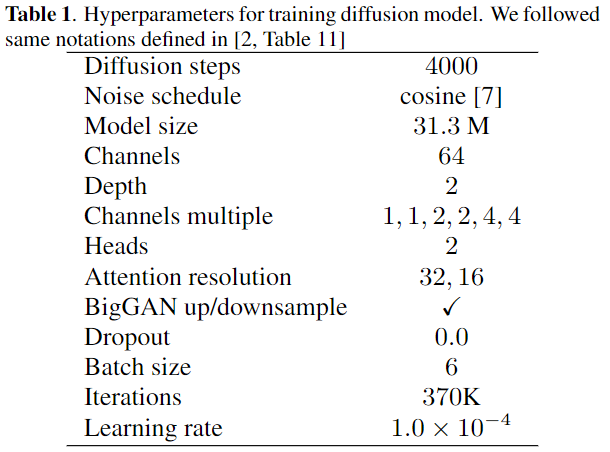Settings of pre-training configurations
In this page, we additionally demonstrate the detailed settings of the training configurations of the pre-trained diffusion model.
The implementation of the network architecture of the pre-trained diffusion model is mostly based on the code provided by the authors of the DDRM paper [1]. We slightly modify some parts as follows. We convert each audio input into a complex-valued STFT representation using a window size of $1024$, a hop size of $256$, and a Hann window. Further, we cut the direct current component of the input signals and input them as $2$-channeled $512 \times 512$ image data to follow the original input configurations. The first channel corresponds to the real value and the second to the imaginary value. We modify the original U-Net architecture of the pre-trained model used on DDRM [2] by adding a time-distributed fully connected layer [3] to the last layer of every residual block.
For the training, we reduce the size of the diffusion model to have the fewer trainable parameters ($31.3$ M), and the training takes less than three days using one NVIDIA A100 GPU. The hyperparameters for the training of the diffusion model are in the following $\textrm{Table 1}$. We also incorporate an adaptive group normalization [2] into each residual block. We train the model using AdamW [4] with $\beta_{1}=0.9$ and $\beta_{2}=0.999$ in $16$-bit precision [5]. We use an exponential moving average over model parameters with a rate of $0.9999$ [6].

Reference
[1] B. Kawar, M. Elad, S. Ermon, and J. Song, “Denoising diffusion restoration models,” in Proceedings of the Advances in Neural Information Processing Systems, 2022.
[2] P. Dhariwal and A. Nichol, “Diffusion models beat GANs on image synthesis,” in Proceedings of the Advances in Neural Information Processing Systems, 2021, vol. 34, pp. 8780–8794.
[3] W. Choi, M. Kim, J. Chung, D. Lee, and S. Jung, “Investigating U-Nets with various intermediate blocks for spectrogram-based singing voice separation.,” in Proceedings of the International Society for Music Information Retrieval Conference, 2020.
[4] I. Loshchilov and F. Hutter, “Decoupled weight decay regularization,” in Proceedings of the International Conference on Learning Representations, 2019.
[5] P. Micikevicius, S. Narang, J. Alben, G. Diamos, E. Elsen, D. Garcia, B. Ginsburg, M. Houston, O. Kuchaiev, G. Venkatesh, and H. Wu, “Mixed precision training,” in Proceedings of the International Conference on Learning Representations, 2018.
[6] Y. Song and S. Ermon, “Improved techniques for training score-based generative models,” in Proceedings of the Advances in Neural Information Processing Systems, 2020, vol. 33, pp. 12438–12448.
[7] A. Nichol and P. Dhariwal, “Improved denoising diffusion probabilistic models,” arXiv preprint arXiv:2102.09672, 2021.